——— N ———
N – symbol for newton.
N3D normalization – Normalization 3-Dimensions. A weighting scheme, used with some formats of Ambisonics, derived using a fairly complex mathematical formula. It is less widely used than SN3D.
NAB – National Association of Broadcasters.
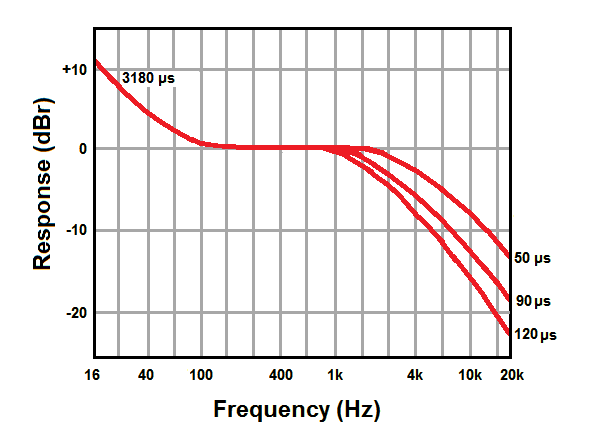
NAB cartridge – see Fidelipac.
NAB curve – a set of standard equalization curves for use with tape machines at various tape speeds, developed by the National Association of Broadcasters. In about 1948, Ampex designed an equalization curve for use with the standard professional recording tape at the time (3M's 111 recording tape). It was similar to equalization curves used by several other manufacturers of tape machines. In 1953, the Ampex equalization curve was adopted as a standard by NARTB (which became the NAB in 1958). Tape equalization curves were originally developed to reduce hiss and to compensate for the fact that magnetic tape did not have a linear response and tended to saturate at higher frequencies. The NAB equalization curve reduced high frequencies and boosted lows (in order to reduce the level of hum) during recording and did the reverse during playback (pre-emphasis and de-emphasis). These boosts and rolloffs were made with a slope of 6 dB/octave. As tape formulations improved, the NAB curve became less of a match for the new formulations, which did not saturate as easily, although hiss remained a problem. Then in the 1960s CCIR developed a new curve that worked better with the new formulations, but it omitted the low frequency pre-emphasis. The CCIR curve was defined for professional machines with tape speeds of 7.5 ips and higher. The CCIR curve became the standard in Europe for professional use, whereas the NAB curve remained the standard in the US for professional use, as well as everywhere for amateur use. The German standards organization DIN also adopted these standards with a few minor differences. Later CCIR merged with the ITU, and eventually became the ITU-R. The IEC assumed the responsibility for the equalization curve. Originally, NAB had no standard for 30 ips until much later. Today the IEC curve (also called IEC characteristic or IEC equalization) and the NAB curve (also called NAB equalization) are designated as IEC1 and IEC2, respectively. These standards are now part of AES-1971. A comparison of NAB and IEC equalization curves is shown in the table below:
| Tape Speed (ips) |
IEC1 Low fc/High fc μs(Hz)/μs(Hz) |
IEC2/NAB Low fc/High fc μs(Hz)/μs(Hz) |
|---|---|---|
| 30 | None/35(4547) | None/17.5(9095) |
| 15 | None/35(4547) | 3183(50)/50(3183) |
| 7.5 | None/70(2274) | 3183(50)/50(3183) |
| 3.75 | Undefined* | 3183(50)/90(1768) |
| 1.875 | Undefined* | 3183(50)/120(1326) |
| *Note: Since the IEC equalization is undefined below 7.5 ips, the NAB curve is normally used. | ||
NAB equalization – see NAB curve.
NAB hub – a tape hub that was 3 inches in diameter used to mount NAB reels on tape machines.
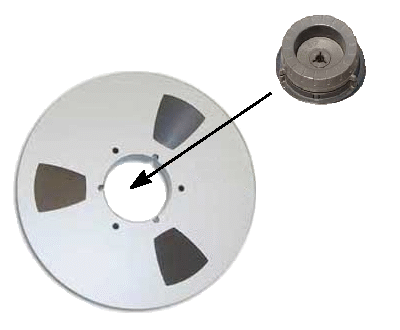
NAB reel – a tape reel, usually 10½ inches in diameter, with metal flanges, that fit over an NAB hub, and typically used with recording tape widths of ½ inch, 1 inch, and 2 inches. They were mainly used in recording studios, broadcast studios, and other professional audio applications.
NAB Standard Reference Level – a signal level defined by the NAB for magnetic recording tape that corresponds to recording level made at 400 Hz on NAB Primary Reference Tape at 7.5 ips with bias adjusted for maximum output, at an output level 8 db below that which produced 3% third harmonic distortion. NAB Primary Reference Tape is a general purpose tape with average characteristics of output, sensitivity, and distortion.
NACC – National Audiovisual Conservation Center.
NAVCC – National Audiovisual Conservation Center.
NAG – Needed Acoustic Gain. In live sound reinforcement, the amount of gain in decibels required by the sound system to achieve an equivalent sound level at the listener farthest from the stage equal to the level the nearest listener would hear without sound reinforcement.
NAMM – National Association of Music Merchants. A trade association of retailers of musical instruments and equipment founded in 1901 and headquartered in Carlsbad, California. It is the organization that holds the NAMM show, the world's largest trade-only event for the music products industry. Only exhibitor employees, NAMM members, and the news media are allowed to attend. Music merchandisers use these shows to unveil their latest new products and technologies. Originally, there was only the Winter NAMM show held every January in Anaheim, California. Later, they added the Summer NAMM show, which is now held in July in Nashville, Tennessee. More recently, an international NAMM show was added in the Fall that competes with its European counterpart, the Musikmesse held in Frankfurt, Germany.
nano- (n) – the SI prefix for a factor of one billionth (10‑9).
nanoweber – a unit of magnetic flux equal to one-billionth of a weber. On recording tape, flux density is measured in nanowebers per meter.
NARAS – National Academy of Recording Arts & Science. See the Recording Academy.
NARB – National Association of Radio Broadcasters. See National Association of Broadcasters.
NARIP – National Association of Record Industry Professionals.
NARM – National Association of Recording Merchandisers.
narration – the act of recounting or telling the details of some action, occurrence, or story, by a person who often does not appear on screen. See also voice over.
narrator – a person who delivers a commentary accompanying a movie, video, broadcast, or piece of music. See also voice over.
narrowband – a relatively limited frequency span. Sometimes spelled narrow band. The opposite of wideband or broadband.
narrowband noise – noise that occurs over a relatively narrow range of frequencies.
NARTB – National Association of Radio and Television Broadcasters. See National Association of Broadcasters.
NAS (Network-Attached Storage) – a computer data storage server connected to a network that provides data storage and access to several clients on the network. It is often manufactured as a specialized computer containing one or more storage drives with redundant storage such as RAID.
nasal – a descriptive term for a sound with a bump around 600 Hz, that sounds like you are singing through your nose. See also honky.
Nashville Number System (NNS) – a simplified method for writing chord charts and melodies using numbers to represent chords. It facilitates changing the key of a song on the spot. It was developed by Neil Matthews of Elvis Presley's backup singers, the Jordanaires, and later expanded by Charlie McCoy. Similar to Roman numeral analysis, NNS usually uses Arabic numerals, but sometimes Roman numerals. There are a number of variations within the system.
Nashville tuning – a guitar tuning technique in which the lower four strings (E, A, D and G) on a six-string guitar are tuned one octave higher than normal. Typically this is accomplished by replacing those strings with lighter gauge strings. Because a change of strings is required to switch between standard tuning and Nashville tuning, many guitarists using Nashville tuning will use a dedicated guitar for it. Examples in which Nasville tuning is used are the Kansas song “Dust in the Wind” and “Wicked Game” by Chris Isaak. Also called high-strung tuning.
National – a term often used to refer to styles of resonator guitars designed by the National String Instrument Corporation and to distinguish them from the styles designed by Dobro.
National Association of Broadcasters (NAB) – a national organization of television and radio personnel that, among other things, has established standards for audio and broadcast systems, equipment, and processes, including the equalization standards for magnetic tape recording. It was founded in 1922 in Chicago as the National Association of Radio Broadcasters (NARB). In 1951 it added the television industry and became the National Association of Radio and Television Broadcasters (NARTB). In 1958 it changed its name to the current National Association of Broadcasters.
National Association of Recording Merchandisers (NARM) – a trade association made up primarily of music retailers that serves music retailing businesses in lobbying and trade promotion.
National Association of Record Industry Professionals (NARIP) – an organization of record and music industry professionals founded in 1998, for networking and promoting the cultural and economic benefits of music and copyright in the US and abroad, and to provide a platform to improve the business.
National Audiovisual Conservation Center (NACC or NAVCC) – the audiovisual archives of the Library of Congress located inside Mount Pony in Culpeper, Virginia. Prior to its establishment, the facility was a
high-security storage facility of the Federal Reserve Board. Approved by the US Congress in 1997, it was purchased by the David and Lucile Packard Foundation on behalf of the Library of Congress. The facility was converted into the National Audiovisual Conservation Center. Construction was completed in 2007 and it opened to visitors in 2008. For the first time, NACC provided a single site to store all 6.3 million pieces of the library's movie, television, and sound collection. The Packard Campus is the largest part of the entire NACC. Other parts include the Library of Congress's Motion Picture and Television Division and Recorded Sound Division reference centers on Capitol Hill, the Mary Pickford Theater, and other Library of Congress audiovisual storage facilities. It is also known as the Packard Campus for Audio-Visual Conservation.
National Broadcasting Company (NBC) – a commercial broadcast radio and television network in the US, headquartered at Rockefeller Center in New York City. It is owned by NBC Universal, a subsidiary of Comcast. It was founded in 1926 by the Radio Corporation of America (RCA), owned 50% by RCA, 30% by General Electric (GE), and 20% by Westinghouse. Charged with antitrust violations, GE sold its share of RCA in 1930. In 1927, NBC created the Red Network, which provided commercially sponsored entertainment and music programming, and the Blue Network, which carried non-commercial broadcasts, primarily news and cultural programming. Later that year, NBC launched the NBC Orange Network (also known as the Pacific Coast Network) on the west coast. The NBC Gold Network (also known as the Pacific Gold Network) began in 1931. The Orange Network carried Red Network programming, and the Gold Network carried Blue Network programming. In 1936, the Orange Network stations became part of the Red Network, and the Gold Network affiliates became part of the Blue Network. Following a complaint to the FCC by the Mutual Broadcasting System in 1934, RCA was ordered to divest itself of either NBC Red or NBC Blue. Although RCA appealed the order all the way to the Supreme Court, it eventually lost the appeal. In 1943 RCA sold the Blue Network to the American Broadcasting System, a company owned by Edward J. Noble, owner of Life Savers candy and the Rexall Drugs. It later became the American Broadcasting Company (ABC). NBC entered the television network business in 1941. In 1986, GE purchased RCA, but later sold it. NBC Universal was created in 2003, when French media company Vivendi merged its entertainment division with GE. Comcast purchased a controlling interest in the company in 2011, and acquired the remainder of GE's stake in 2013.
National Bureau of Standards (NBS) – see National Institute of Standards and Technology.
National Electrical Manufacturers Association (NEMA) – a trade association of electrical equipment manufacturers, founded in 1926 and headquartered in Rosslyn, Virginia. Its member companies manufacture products used in the generation, transmission, distribution, control, and end use of electricity. In is involved in lobbying activities and publishes standards, application guides, and technical papers.
National Institute of Standards and Technology (NIST) – A US government standards organization that advances measurement science, standards, and technology. Previously know at the National Bureau of Standards (NBS).
National Music Publishers' Association (NMPA) – a trade association with over 800 members in the music publishing industry. The NMPA goals are to protect the property rights and to lobby federal legislators and regulators on behalf of its members. It was founded in 1917 as the Music Publishers' Protective Association (MPPA) to end the practice of vaudeville theaters requiring publishers to pay for performing their music. In 1927, the NMPA founded the Harry Fox Agency, an agency for collecting fees for mechanical licenses. The MPPA changed its name to the National Music Publishers Association in 1966. In 2015, the NMPA sold the Harry Fox Agency to SESAC.
National Recording Preservation Board (NRPB) – an advisory group authorized by the National Recording Preservation Act of 2000 concerned with the preservation of recorded sound. The Board is appointed by the Librarian of Congress and consists of one member and one alternate from each of seventeen organizations representing composers, musicians, musicologists, librarians, archivists, and the recording industry plus up to five at-large members. The Preservation Act was established as a comprehensive national program to ensure the survival, conservation, and increased public availability of America's sound recording heritage. The act also provided for the National Recording Registry and a fund-raising foundation.
National Recording Registry – a list of sound recordings of cultural and historical significance in the US. These recordings are preserved in the Library of Congress. The registry was authorized by the National Recording Preservation Act of 2000, which also created the National Recording Preservation Board (NRPB) and and a fund-raising foundation to aid in this effort.
National Research Development Corporation (NRDC) – a British government body established to transfer technology from the public sector to the private sector.
National String Instrument Corporation – a company formed in 1927 to manufacture the first resonator guitars, ukuleles, and mandolins. The company was formed by John Dopyera, who invented the resonator, and George Beauchamp. The first resonator guitars had metal bodies and a tricone resonator. Later wooden-body designs were added. In 1928, Dopyera left National and formed the Dobro Manufacturing Company with four of his brothers. They created a single resonator design, with an inverted cone, which was less expensive to produce and louder than the National designs. National responded by introducing their own single resonator design, the “biscuit,” but also continued to produce the tricone. In 1932, National and Dobro merged to form the National Dobro Corporation. In 1989, a new company was formed by Don Young and McGregor Gaines, in a California garage called National Reso-Phonic Guitars. They began producing reproductions of resonator guitars based on the John Dopyera designs. In 1994, National Dobro Corporation was acquired by Gibson.
native – (1) Software that runs on a computer operating system that does not require additional hardware or software. (2) A plug-in that is host-based, i.e. the software uses the computer processor rather than a separate dedicated DSP.
Native Instruments – a technology company, founded in 1996, and headquartered in Berlin, Germany, that develops and markets audio software and hardware. Although it started as a software company, it later expanded into audio equipment. Its products include software synthesizers, samplers, effect processors, sound libraries, virtual instruments, audio interfaces, as well as software and hardware for disc jockeys.
native signal processing (NSP) – a system developed by Intel that uses powerful microprocessors for signal processing rather than using a separate DSP chip.
nats – short for natural sounds.
NATSOT – NATural Sound On Tape. An audio recording of the background noises that are present in a scene or on location, such as wind, water, crowds, and traffic, a term used primarily in television and film production. Also called an ambience track. See also SOT.
natural – a symbol (♮) in music that returns a note to its original pitch after having been sharpened or flattened, or cancels out a sharp (♯) or flat (♭) as indicated by a key signature.
natural frequency – see resonant frequency.
natural minor scale – see minor scale.
natural-phase equalizer – see minimum-phase equalizer.
natural reverb – reverberation created by sound reflecting from walls, ceilings, floors, and other objects in an actual physical space, as opposed to artificial reverb.
natural sounds – sounds produced by natural sources in their normal environments, including the sounds of living organisms, as well as natural, non-biological sources. Called nats for short.
NBC – National Broadcasting Company.
NBS – National Bureau of Standards. See National Institute of Standards and Technology.
NCB – Balanced Noise Criteria.
NC contours – Noise Criteria contours. See noise criteria.
NC curves – Noise Criteria curves. See noise criteria.
N curve – Normal Curve. See Academy curve.
NCT – NonChord Tone.
near-coincident pair – a group of stereo microphone techniques using two microphones, spaced approximately 7" (18 cm) to 12" (30 cm) apart (to somewhat approximate the distance between ears on a human head) and angled apart symmetrically on each side of center. This technique is preferred by the broadcast industry because it provides greater mono compatibility. Sometimes called semi-coincident pair. The following techniques are included in this group: DIN, EBS, Faulkner array, NOS, ORTF, RAI, and sometimes A-B. See also coincident pair (Blumlein array, mid-side, and X-Y pair) and spaced pair (A-B, Decca tree, spaced cardioid, and spaced ominis). See also table comparing various stereo microphone techniques.
near-end crosstalk (NEXT) – interference between an adjacent pair of wires in a cable measured at at the near end of the circuit. See also far-end crosstalk.
near field – very close to the sound source, a point at which the ratio of direct sound to reflected sound is great enough for the reflected sound to be essentially negligible. Near field can refer to both miking a source as well as reproducing a sound. Because with studio studio monitors the listener hears more of the direct sound than the reflected sound of the room, the terms direct field or direct sound has been suggested as alternative terminology, since the term Nearfield® is a trademark of Edward M. Long of Calibration Standard Instruments (CSI). However, it has come into common usage particularly with studio monitors. Sometimes called close field. See also far field.
near field communication (NFC) – a standard developed jointly by Philips and Sony for short-range wireless communication using magnetic induction between two electronic devices, one of which is usually a portable device such as a smartphone, when they are brought within about 2 in (5 cm) of one other. NFC device can work in three modes: (a) NFC card emulation, that enables devices such as smartphones to act like smart cards and perform transactions such as payment or ticketing, (b) NFC reader/writer, that allows devices to read information stored in labels and other objects, and (c) NFC peer-to-peer, that allows devices to communicate with each other and exchange information.
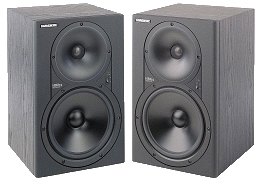
near-field monitors – studio monitors (speakers) designed for listening at close distances, typically three to five feet, so as to minimize the effects of control room acoustics. See also midfield monitors and far-field monitors.
near zero latency – having a very low delay in processing a signal, low enough as to not be noticed. See latency and zero latency.
neck – (1) The part of string instruments that extends from the main body and includes frets (if any), fingerboard or fretboard, tuning pegs, and headstock. (2) The curved portion of some woodwind instruments, such as the saxophone.
neck joint – the point on the body of a string instrument at which neck is attached. For many instruments, the neck is glued to the body, but some instruments, such as some electric guitars and basses, have bolt-on necks, consisting of a neck plate with screws that hold the neck in place.
needle – slang for phonograph stylus.
needle drop – a fee paid to a music publisher each time a piece of music is used, typically for broadcasting. The phrase needle drop goes back to the days when a needle (stylus) was actually placed on a record. Although analog records are rarely used today, the term implies that a payment is due each time a song is played.
needle noise – see surface noise.
needle scratch – see needle talk.
needle talk – the sound that a stylus makes as it vibrates traveling through a record groove. Although modern phonograph cartridges have very low needle talk, older 78-rpm players sometimes created substantial amounts of needle noise. Also needle scratch. See also surface noise.
negative – (1) A number or value less than zero. The opposite of positive. (2) In a plot of waveforms, audio signals, and similar quantities, the portion that is below the center line (which is usually zero, but not always). See also absolute polarity. (2) One of the two fundamental types of electric charges, the other being positive. An atom with more electrons than protons will have a negative charge. A negatively charged object will repel other negatively charged objects and attract positively charged objects.
negative feedback (NFB) – feeding a portion of an amplifier output back into the input in such a manner as to improve linearity, to lower output impedance, to increase damping factor, or improve frequency response.
negative flanging – see additive flanging.
negative-ratio compression – when the compression ratio of a compressor is set to a negative value, a setting available only on some compressors. With a positive-ratio compressor, the highest compression that can be achieved is an infinite ratio of ∞:1, which flattens the signal at the threshold limit. A negative-ratio actually can reduce it to below the threshold.
NEMA – see National Electrical Manufacturers Association.
NEMA 1-15 – NEMA standard for a type A plug household electrical plug.
NEMA 5-15 – NEMA standard for a type B plug household electrical plug.
neodymium-iron-boron (NIB) magnet – see neodymium magnet.
neodymium magnet – a permanent rare earth magnet made from an alloy of neodymium (a rare earth metal), iron, and boron that forms Nd2Fe14B, that was developed by General Motors and Sumitomo Special Metals in 1982. Neodymium magnets are the strongest type of permanent magnets currently available, and have replaced other types of magnets in various applications, such as hard disk drives, motors in cordless tools, and speaker voice coils. Also called a neodymium-iron-boron magnet, NIB magnet, or neo magnet.
neo magnet – see neodymium magnet.
neper (Np) – a logarithmic unit for ratios of various measurements, named for John Napier, who invented logarithms. Being similar to the more familiar decibel, the neper is used to compare physical quantities such as gain and voltage, but it uses the natural logarithm (based on Euler's number (e), which is equal to 2.71828....) instead of the base 10 log. A neper is calculated using the formula Np = ln x1/x2 = ln x1 - ln x2 where ln is the natural logarithm and x1 and x2 are the quantities being compared. One neper equals approximately 8.658 dB and 1 dB equal approximately 0.1151 Np.
Netflix, Inc. – a streaming-media provider and production company headquartered in Los Gatos, California, founded in 1997 by Reed Hastings and Marc Randolph in Scotts Valley, California. It provides subscription-based streaming services offering a library of movies and television programs, some of which are produced in-house by Netflix.
Netflix Preferred Fulfillment Partner (NPFP) – a worldwide network of media fulfillment companies that supply content to Netflix. Each provider must meeting strict standards established by Netflix.
Netflix Sound Mix Specifications & Best Practices – a set of standards required by Netflix for audio that accompanies movies and videos submitted to them by their suppliers. Those specifications can be found at Netflix Sound Mix Specifications & Best Practices v1.1.
net radio – see internet radio.
network – (1) A group of computers or devices connected together to share resources, such as the internet, printers, and file servers. See also local area network. (2) A telecommunications group designed to distribute radio and television program content, in which a central operation provides programming to many stations or providers. Also called a television network or radio network. (3) A group or system of interconnected items, such as a network of resistors. (4) To connect or operate as a network.
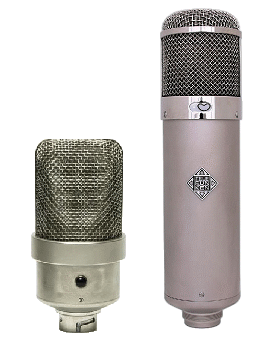
Neumann U 47 (R)
network audio – audio that is streamed from a computer or server on a network, using a network connection, such as Wi-Fi, Ethernet, etc.
network adapter – see network interface controller.
network interface card – see network interface controller.
network interface controller (NIC) – a hardware component used to connect computers to a network. Also known as a network interface card, network adapter, LAN adapter, or physical network interface.
network time protocol (NTP) – a communication protocol to synchronize clocks within a computer network. NTP is designed to synchronize computers clocks to within a few milliseconds of Coordinated Universal Time (UTC). NTP can achieve better than one millisecond accuracy in local area networks (LANs) under ideal conditions and can usually maintain time to within tens of milliseconds over the internet, but asymmetric routes and network congestion can cause errors of 100 ms or more.
Neumann M49 – a condenser microphone introduced by Neumann in 1949. Known for its especially smooth sound on vocals, it was innovative in that it had a remote-controlled pickup pattern, which allowed the engineer easily to adjust the directional pattern from the control room. This innovation was developed by Herbert Grosskopf of the Institute Fur Rundfunktechnic (IRT), a German technical standards organization. The mic used the M7 capsule, the same one as used in the U 47. It was a favorite in recording studios on pop and jazz vocals in the 1950s and 1960s.
Neumann Microphones – see Georg Neumann GmbH.
Neumann U 47 – a large-diaphragm tube condenser microphone introduced by Neumann in 1947, using the legendary M7 microphone capsule and the VF14M vacuum tube. Telefunken manufactured the VF14 tube for use in radios, but not all of them would meet Neumann's specs. So Neumann tested all of them and those that were acceptable were marked M for “mikrophon.” The U 47 was the first switchable-pattern condenser microphone, and could be switched between cardioid and omni patterns. Early U 47s used the M 7 capsule, which was replaced by the K 47 in 1958. Originally the U 47 was distributed as the Telefunken U 47, but in 1958, Neumann took over distribution from Telefunken, and restored the Neumann logo. The U 48 version was later introduced by Neumann, with the main difference being the pickup pattern. The U 48 offered cardioid and figure-8 patterns instead of the cardioid and omnidirectional patterns of the U 47. Because Telefunken stopped producing the VF 14 tubes in 1957, Neumann discontinued the U 47 in 1965 and introduced the U 47 FET in 1969. The U 47 has become one of the most revered vocal microphone in history. Dozens of microphone designers have tried to duplicate its sound.
Neumann U 48 – see Neumann U 47.
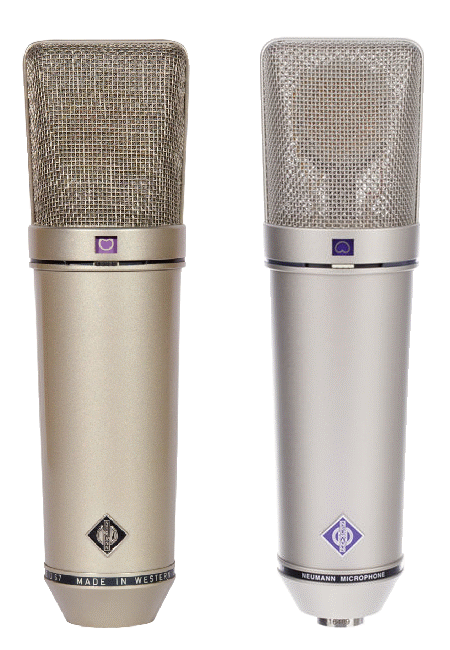
Neumann U 87 (R)
Neumann U 67 – a multipattern large-diaphragm tube condenser microphone introduced by Neumann in 1960 as the U 60, intended as a replacement for the U 47. After a small run as the U 60, it was renamed the U 67. It had a newly designed capsule, the K67, and used the Telefunken EF86 vacuum tube. In a addition to a switchable polar pattern, it also had a -10 dB pad. The U 67 soon gained a reputation as a versatile microphone, and became known as the workhorse of professional recording studios.
Neumann U 77 – see Neumann U 87.
Neumann U 87 – a multipattern large-diaphragm condenser microphone introduced by Neumann in 1967, as a solid-state replacement for the U 67. It used the K67 capsule, but instead of a vacuum tube, it used FET circuitry. It was available in two configurations, the U 87, which used a Tuchel connector, and the U 87i, which had an XLR connector. In 1986, the electronic were modified, and it was issued as the U 87Ai. Since by that time the XLR had essentially replaced the Tuchel connection, there was no A model without the i. The original version of the U 87 was designed to operate either on internal batteries or phantom power. When the U 87Ai was introduced, the type of battery used was no longer available and the battery option was eliminated. Along the way there were some modifications to the capsule to accommodate the various changes, but the U 87Ai returned to the K67. From 1968 to 1974, there was also an AB-powered version of this microphone, which was designated as the U 77.
Neutrik AG – a company, headquartered in Schaan, Liechtenstein, that designs and manufactures connectors used in audio and video recording studios and concert sound systems. Their product range includes XLR-type connectors, Speakon® connectors, powerCON connectors, patch bays, BNC connectors, and special connectors for industrial applications.
Neve 1073 – a solid-state microphone preamplifier designed by Rupert Neves of Neve Electronics in the early 1970s. It featured a 3-band equalizer and high pass filter. It is considered by many to be the most famous and possibly most desirable preamp in the history of recording. AMS Neve re-ssued an updated version of this preamp in 2004. There are also several plug-ins that emulate this preamp.

Neve 80-series consoles – a series of mixing console designed and manufactured by Neve Electronics during the 1970s. It began with the 1073-equipped Neve 8028, a 24-channel analog console in 1973. The Neve 8048, introduced in 1974, had 1081 channel amplifiers with 4-band EQ. The first in-line-monitor, the Neves 8058 and 8068, were launched in 1976. In 1978, the Neves 8078 was introduced, the last of the handwired production 80-series desks. The Neve 8088 was a 32-channel, solid state console.
Neve Electronics – see AMS Neve.
new philharmonic pitch – see pitch standard.
newton (N) – the SI unit of force equal to the force needed to accelerate 1 kilogram of mass at the rate of 1 meter per second squared. It equals 100,000 dynes. It is named after Isaac Newton.
New York compression – see parallel compression.
New York City compression – see parallel compression.
Next Generation Audio (NGA) – a collection of various audio technologies and techniques being created to deliver an improved and customizable experience for home television viewers.
NFB – Negative FeedBack.
NGA – Next Generation Audio.
NHK (Nippon Hoso Kyokai) – Japan Broadcasting Corporation. Japan's national public broadcasting organization, a publicly owned corporation funded by television license fees paid by viewers. NHK Science & Technology Research Laboratories (STRL) is a division of NHK and conducts a wide range of research and development activities involving broadcasting technology as well as working to create industry standardization.
NIB magnet – Neodymium-Iron-Boron magnet. See neodymium magnet.
NIC – Network Interface Controller or Network Interface Card.
NICAM – Near Instantaneous Companded Audio Multiplex. An early lossy data compression scheme for digital audio, originally developed in the early 1970s for broadcasting networks to transmit digital audio data with video.
NIST – National Institute of Standards and Technology.
nitrocellulose – see cellulose nitrate.
nitrocellulose lacquer – see lacquer.
NLE – Non-Linear Editing.
NMOS – Networked Media Open Specifications. An evolving group of standard specifications for networked media developed by AMWA that is available to both suppliers and end users with the goal of delivering interoperability and increasing the choice of products across a wide range of suppliers. When possible, the specifications are developed using internet standards or internet-friendly techniques that complement and co-exist with industry specifications.
NMPA – National Music Publishers' Association.
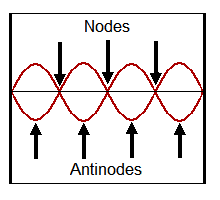
node – a point of minimum sound pressure level in a standing wave, as opposed to an antinode, which is point of a maximum sound pressure. Sometimes called a null.
noise – (1) A sound, especially one that is unwanted, unpleasant, or annoying. (2) Any unintentional or undesired signal in an audio or electrical signal. Noise is typically added by equipment in the audio signal path. Therefore, noise is any signal that occurs when there is no audio in the signal path. (3) Irrelevant or meaningless data or output that occurs along with desired information. See also noise color.
noise barrier – see soundproofing.
noise cancellation – a method for reducing noise levels by adding a polarity-reversed signal of the unwanted sounds to the desired signal to partially cancel it. This process is used in noise-canceling headphones and noise-canceling microphones. Also called active noise cancellation, active noise control, active noise reduction, or antinoise.
noise-canceling headphones – a type of headphones containing a built-in microphone that picks up ambient sounds and adds them back to the headphone signal out-of-phase, which lowers the background noise.
noise-canceling microphone – a dynamic microphone designed to filter out ambient noise, for use in noisy environments. Both sides of the diaphragm are exposed to the sound field so that close direct sound strikes primarily one side of the diaphragm, while distant sounds strike the diaphragm from all sides which causes them to cancel out.
noise color – an indication of the amount of energy in sound at various frequencies. Such energy-frequency relationships are indicated by various colors. White noise has the same energy content at every frequency, while black noise has no energy and represents silence. Noise that is not white is called colored noise and has more energy at some frequencies than others, analogous to colored light. See table below for comparison of noise colors.
| Noise Color | Noise Energy |
|---|---|
| White Noise | Equal amount of energy in all frequency bands |
| Grey Noise | White noise weighted to sound equally loud to the human ear at all frequencies |
| Purple Noise | Energy increases at 6 dB per octave Has the most energy in the higher frequencies |
| Blue Noise | Energy increases at 3 dB per octave |
| Green Noise (Unofficial) |
The mid-frequencies of white noise “The background noise of the world” |
Orange Noise (Unofficial) |
Noise stripped of harmonious frequencies |
| Pink Noise | Energy decreases at 3 dB per octave Contains the same SPL in each octave band |
| Red Noise | Energy decreases at 6 dB per octave Ambient underwater noise from distant sources (oceanographic term) The same as brown noise |
| Brown Noise | The kind of the signal noise produced by brownian motion The same as red noise |
| Black Noise | Silence or silence with an occasional spike |
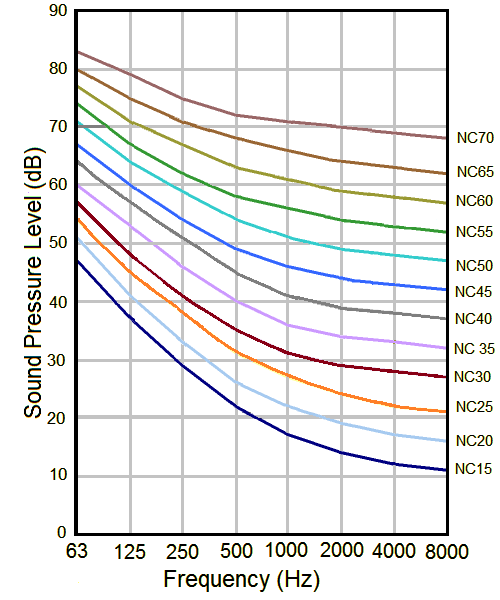
noise criteria (NC) – an industry standard consisting of a set of curves that define design goals for the maximum allowable noise in a given space. They describe the relative loudness of a space, using a range of frequencies as opposed to simply measuring a single decibel level. They primarily are concerned with the noise produced by ventilation systems, but also may include other types of noise such as mechanical noise. The NC curves, developed in 1957, define the maximum allowable sound pressure level (SPL) in octave-bands over the entire audio spectrum. There are 11 curves that specify design goals for noise levels for a broad range of different purposes. For example, an NC value of 25-35 is recommended for schools, while 15-18 is recommended for concert halls. NC should be used where excessive noise would be irritating or detrimental to the users, especially where speech intelligibility is important. Among other spaces, NC should be considered for recording studios,, lecture halls, performance venues, worship spaces, and educational facilities. NC is the most commonly used standard in the US, while noise rating (NR) is usually used in Europe. Several other alternate standards have been proposed, such as room criteria (RC) and balanced noise criteria (NCB). The preferred noise criteria (PNC) curves were developed in 1971, and added limits for low-frequency rumble and high-frequency hiss. For this reason, they are preferred over the older NC standards.
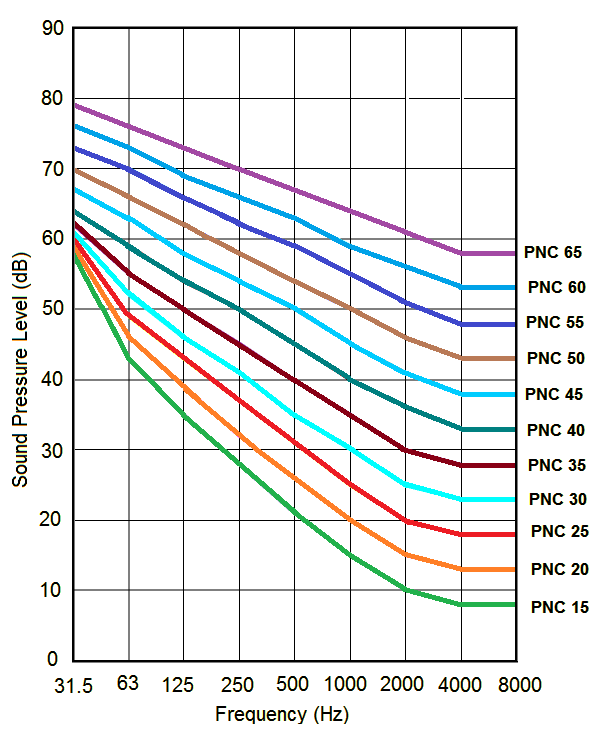
noise criteria curves – see noise criteria.
noise dose – see permissible exposure limits.
noise dosimeter – see sound exposure meter.
noise exposure – see permissible exposure limits.
noise figure – the ratio of the output noise to the input noise of a device expressed in decibels. Values are always positive, with a theoretical noise-free device having a noise figure of 0 dB.
noise filter – a device that passes desired audio frequencies, while reducing undesired noise at other frequencies.
noise floor – the level of background noise in a signal that establishes the lowest usable signal. All audio devices have a certain amount of inherent noise that contributes to the noise floor.
noise gate – a gate designed to reduce noise in relatively silent passages of music.
noise generator – a device to create a random audio signal of various noise colors containing all frequencies at the same time. Noise generators are used to synthesize the sound of snare drums and cymbals, and for adding special effects to other sounds. Sometimes called a noise oscillator.
noise masking – adding white noise to an audio signal to mask background sounds or to make them less distracting or unintelligible.

noise oscillator – see noise generator.
noise print – a sample of noise, such as hiss or ambient room noise, that needs to be removed or reduced with a noise reduction application. See print-based noise reduction.
noise rating (NR) – a system for evaluating the noise in a space, developed by the ISO to determine the acceptable indoor environment for hearing preservation, speech communication, and annoyance. Noise rating plots for different sound pressure levels are established for acceptable sound pressure levels (SPL) at various frequencies. Acceptable sound pressure levels vary with the room and its use, with different curves for each type of use defined by an NR number. NR is commonly used in Europe, while noise criteria (NC) is more often used in the US. See also balance noise criteria (NRB) and room criteria (RC).
noise reduction (NR) – (1) Any of several methods that reduce the level of undesired noise in an audio signal or device, including software, plug-ins, and circuit designs. Sometimes called noise suppression. See also Dolby and dbx. Some characteristics of some noise reduction systems are shown in the table below. (2) The same as sound reduction.
| NR System |
Application | Comp- ression Ratio |
SNR Increase | Headroom | Emphasis | Split Band | Freq- uency Range |
|---|---|---|---|---|---|---|---|
| dbx-I | Open reel | 2:1 | 30 dB |
+10 dB | 12 dB | None | Linear |
| dbx-II | Cassette | 2:1 | 30 dB | +10 dB |
12 dB | None | Linear |
| Dolby A | Open reel | Up to 10 dB (<9 kHz) 10 - 15 dB (10- 15 kHz) |
4 Fixed | HF | |||
| Dolby B | Cassette | About 10 dB (>4 kHz) |
Modified Dolby A | None | HF | ||
| Dolby C | Cassette | About 15 dB (>2 kHz) | Modified Dolby A | None | HF | ||
| Dolby S | Cassette | Up to 24 dB (HF) Up to 10 dB (LF) |
Modified Dolby SR | 3 Fixed 2 Sliding |
HF LF |
||
| Dolby SR | Open reel | Up to 25 dB | 5 Fixed 5 Sliding |
All |
noise reduction coefficient (NRC) – a specification for the effectiveness of acoustic absorption materials derived by averaging the absorption coefficients across a range of frequency bands.
noise shaping – a signal processing method used during digital-to-analog conversion or digital-to-digital conversion to reduce the potential for noise often created in the conversion process. See dither.
noise suppression – see noise reduction.
Nokia – a multinational communications and information technology corporation headquartered in Espoo, Finland (a suburb of Helsinki). In 2013, Nokia sold its mobile phone operation to Microsoft to form the Microsoft Mobile subsidiary.
NOM – Number of Open Mics. A term used with the automatic microphone mixer to indicate the number of active microphones. The automatic mixer automatically decreases the gain on unused mic channels and increases the gain on active channels, while maintaining a constant overall level. In order to do this effectively it must keep track of the number of open mics (NOM). The NOM term is also used by live sound technicians.
nominal audio level – see nominal operating level.
nominal level – see nominal operating level.
nominal frequencies – see preferred frequencies.
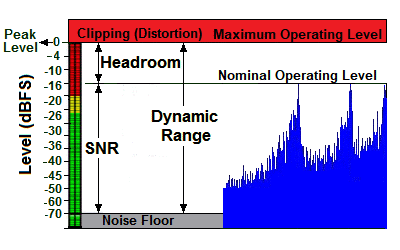
nominal operating level – (1) The normal signal level at which a piece of audio equipment is designed to operate. Often used to refer to the zero reference level, although that term is more precise. (2) The audio level at which a recording studio normally produces music tracks, corresponding to 0 VU. This level is typically between -10 dBFS and -20 dBFS. Also called nominal audio level or simply nominal level. See also maximum output level.
nonchord tone (NCT) – a note that is not part of a chord, but is played at the same time as the chord, while chord tones are the signal pitches that make up a chord. Nonchord tones are often used to add flavor and embellish the music. Also called a nonharmonic tone, embellishing tone, or passing tone.
non-destructive editing – a method of editing audio files in such a manner that the original audio file is not changed, only pointers to the file, so that any changes can be undone.
non-destructive recording – a method of recording in which new takes or tracks are recorded while preserving the previously recorded tracks. The previous tracks have file names and locations that can be used to return to a previous take if desired.
non-diegetic sound – a sound that is not present nor implied as being present in a movie, video, or video game, such as the voice of a narrator or background music. Non-diegetic sound is any sound presented as originating from outside the world being depicted. It is sometimes called commentary sound. It is the opposite of diegetic sound.
non-diversity – see diversity.
non-directional microphone – same as an omnidirectional microphone.
non-drop frame – a time code that does not use the dropframe format. For every frame of video, there is a corresponding time code number. In most cases, timecode is non-drop frame. The main exception is NTSC color video, with a frame rate of 29.97 fps, that has to periodically drop a frame for the time code to correspond to whole numbers. NTSC can use either drop frame or non-drop frame timecode.
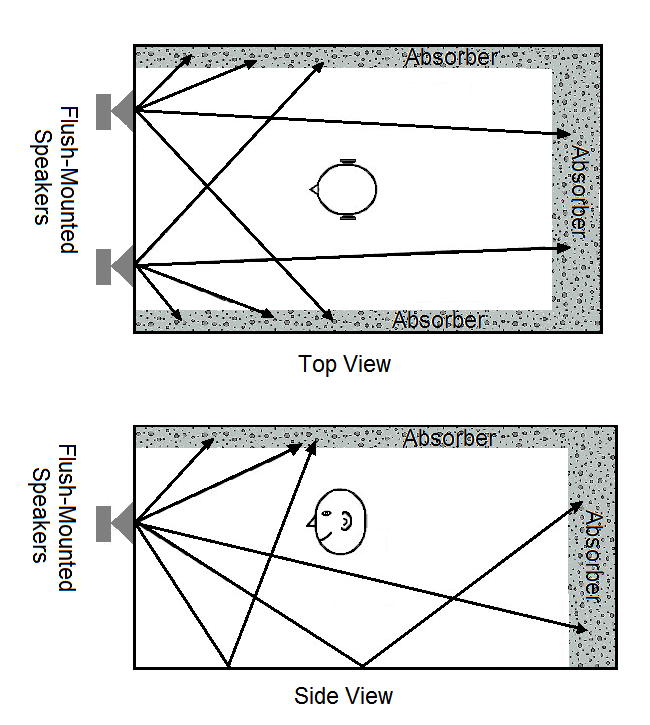
non-environment – a control room design where the monitors are flush-mounted, the ceiling, side, and rear walls are covered with sound absorbing material, but the front wall and floor are not. This arrangement removes most reverberations and reflections resulting in a space that is almost acoustically dead, providing a sound with good detail and excellent stereo imaging. Compare with LEDE, ESS, RFZ, and controlled image designs.
nonharmonic tone – see nonchord tone.
nonlinear – (1) A descriptive term for a storage medium in which data can be accessed directly rather than sequentially, and therefor can be read almost instantly, such as a hard disk, compact disc, or DVD. (2) A change in output that is not proportional to input. See nonlinear distortion.
nonlinear distortion – a distortion in an audio signal, which occurs when new frequency components are generated, and includes harmonic distortion and intermodulation distortion.
nonlinear editing (NLE) – a system that allows audio to be broken into regions, clips, or playlists that can be moved, copied, or pasted together in various ways to create an audio file, as opposed to a tape-based system that cannot be so easily edited.
nonlinear-phase equalizer – see minimum-phase equalizer.
Nordic Television – Nordisk Television AB. A commercial television system in Sweden founded in 1984. It began broadcasting in 1990 as the TV4 Group. In 2006, it was acquired by Bonnier and Proventus, which owned Nordic Broadcasting Oy. Proventus sold its shares in Nordic Broadcasting to Bonnier in 2007, making it a fully owned subsidiary of Bonnier. In 2008 it changed its legal name to TV4-Gruppen (TV4 Group).
normal – the condition in a patchbay when an internal connection allows a signal to pass through when no plug is inserted, but breaks the connection when a plug is inserted. If the connection is half-normal, then the connection is not broken when a plug is inserted, in effect creating a Y connection. Sometimes called full normal to distinguish it from half normal. See also normalled connection.
normal incidence sound absorption coefficient – the fraction of the perpendicularly incident sound power that is absorbed by a material. That which is not absorbed is reflected back toward the sound source. The reflection coefficient represents the reflected portion. Both coefficients are used to evaluate the acoustical performance of a material to minimize reflections. See absorption coefficient.
normalization – see normalize.
normalize – to adjust the level of an audio signal to maintain a consistent level of loudness. There are several types of normalization. Peak normalization is an automated process that changes the level of each sample in a digital audio signal by the same amount, so that the loudest sample reaches a specified level, typically within 1 to 2 dB of 0 dBfs. However, different audio tracks may have different perceived levels of loudness, especially if one track has a very large peak. RMS normalization adjusts each track based on its average level. While this approach produces more consistent results, the perceived loudness can still vary. Loudness normalization which specifies the use of K-weighting is used in the broadcast industry. See ITU BS.1770. Part of the job of a mastering engineer is to adjust all the tracks in an album to the same level. This requires the mastering engineer to adjust the perceived level by ear. British spelling is normalise.
normalized connection – see normalled connection.
normalled connection – a jack connection in a patchbay or mixer that allows a signal to pass through when no plug is inserted, but breaks the connection when a plug is inserted. Sometimes called a break jack in the US and a normalised connection in Britain.
normal mode – see differential mode.
NOS – (1) New Old Stock. An item that is in new condition, but discontinued and no longer available from the manufacturer. (2) Nederlandsche Omroep Stichting (the Dutch broadcasting agency). (3) A standard established by NOS for a stereo microphone technique that specifies two cardioid microphones angled at 90 degrees and spaced 30 cm (12 inches) apart. While other specification use 110 to 120 degrees, the 90 degree angle is easier to setup. It falls into the near-coincident pair category of techniques. Other techniques in this category include A-B, DIN, EBS, Faulkner array, ORTF, RAI. See also coincident pair (Blumlein array, mid-side, X-Y pair) and spaced pair (A-B, Decca tree, spaced cardioids, spaced omnis). See table comparing various stereo microphone techniques.
NOS technique – see NOS, definition #3.
notation software – see score editor.
notation processor – see score editor.
notch – (1) A narrow band of audio frequencies. (2) To reduce the level of a narrow band of audio frequencies.
notch filter – a device that reduces the level of a narrow band of audio frequencies within an audio signal and passes the remainder. The opposite of a slot filter. A notch filter is a bandstop filter with a narrow stopband (high Q factor). See also lowpass filter, highpass filter, bandpass filter, allpass filter, and slot filter.
note – see music note.
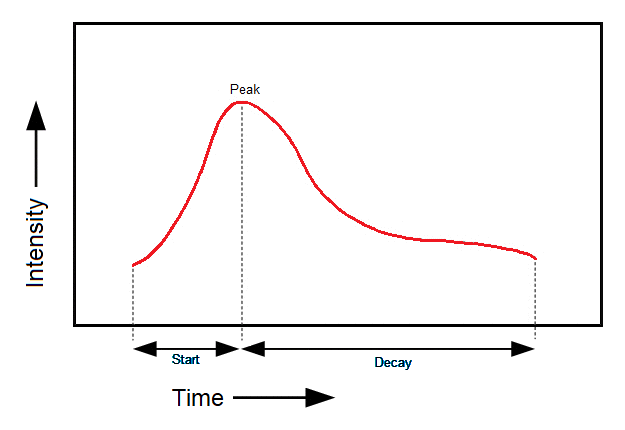
note number – see MIDI note number.
note shaping – varying the intensity of a music note as it is played or sung to provide a more interesting and dynamic sound.
note value – a numerical quantity that indicates the relative duration of a music note. The note value is indicated by the shape of the note head (solid or open), the presence or absence of a stem, and the presence or absence of flags (also called beams, hooks, or tails). A whole note has a note value of 4, half note 2, quarter note 1, eighth note 0.5, etc. A dotted note increases the note value by 50%.
Novation Digital Music Systems Ltd. – a musical equipment manufacturer located in Buckinghamshire, England. It was founded in 1992 as Novation Electronic Music Systems. It specializes in MIDI controllers, analog and virtual analog synthesizers, virtual controllers, and audio interfaces. In 2004, Novation was acquired by Focusrite.
NPFP – Netflix Preferred Fulfillment Partner.
NPR – National Public Radio. A non-profit membership radio network funded by private and public donations that syndicates news and cultural programming to a network of over 900 public radio stations in the US.
NR – Noise Reduction.
NRC – Noise Reduction Coefficient.
NRDC – National Research Development Corporation.
NS-10 – see Yamaha NS-10.
NSP – Native Signal Processing.
NT1 and NT1A – see RØDE NT1.
NT2 – see RØDE NT1.
NTSC – (1) National Television Standards Committee. The organization that defined the format for color analog television in the US. (2) The standard this organization developed for analog color television transmission, which now has been replaced by the ATSC standard.
NTP – Network Time Protocol.
Nuage – a system of hardware and software developed in collaboration by Yamaha and Steinberg that consists of a control surface, audio interface, and the Nuendo DAW designed for use in post production. Optional components, such as monitors and a Nuendo SyncStation, may be added.
nudge – a function found on many DAWs for making small adjustments in the placement of audio clips or regions, typically by using the left and right arrows on the computer keyboard to move them forward and backward by a selected timing increment.
Nuendo – a digital audio workstation (DAW) developed by Steinberg. It is aimed primarily at the audio and video post-production market.
Nuendo SyncStation – a synchronizer developed by radioSteinberg for sample-accurate synchronization of standard- and high-definition video with the Nuendo audio and post-production system.
null – (1) Having zero energy or movement. (2) The positions at which all faders are set at the beginning of an update pass through a mix during console or mixer automation. (3) The zero point of a control. (4) The position around a directional microphone where the pickup is lowest, also called the null angle, rejection node, or angle of maximum rejection. (5) The point at which phase cancellation occurs.
null angle – see angle of maximum rejection.
nut – a small strip of bone, plastic, metal, or other hard material that supports the strings of a stringed instrument at the end next to the headstock or scroll. The nut sets the spacing of the strings across the neck and holds the strings at the proper height above the fingerboard. The distance between the nut and bridge establish the the vibrating length of each open string.
Nuvistor – a type of vacuum tube introduced by RCA in 1959. Nuvistors were made to compete with the then new transistor technology. Nuvistors were subminiature tubes in metal housings and were much smaller than conventional tubes of that time, nearly approaching the size of early discrete transistor casings.
NYC compression – see parallel compression.
Nyquist frequency – the highest frequency that can be reproduced accurately when an audio signal is digitally encoded at a given sampling rate and is equal to half the sampling rate. For example, a sampling rate of 44.1 kHz was chosen as the standard for the compact disc so that it could reproduce an audio signals up to 20 kHz. The Nyquist frequency is not the same as the Nyquist rate. It was named after electronic engineer Harry Nyquist. Also called a half-sampling frequency or folding frequency.
Nyquist noise – see thermal noise.
Nyquist rate – the lowest sampling rate that will permit accurate reconstruction of a sampled analog signal. Technically, it is two times the bandwidth of a bandlimited function or a bandlimited channel. The Nyquist rate is twice the maximum component frequency of the function being sampled.
Nyquist sampling theorem – see sampling theorem.
Nyquist-Shannon theorem – see sampling theorem.
Note: We believe this is the largest dictionary (glossary) of terms specific to usage within the recording industry that is currently available on the internet, with more than 8,800 entries, nearly 800 illustrations, and dozens of tables. Some of the terms have different or additional meanings in other situations, especially within the electronic, automotive, scientific, and computer industries. Of necessity there are obvious overlaps into other fields such as music, electronics, and computers, but such excursions are limited to information deemed pertinent to the knowledge required to operate and/or participate effectively in the workings of a recording studio. Also included are terms related to sound reinforcement (live performances) including wireless microphone technology because a working knowledge of that terminology is necessary for recording at live performance venues. Because recording studios also record audio for video and motion pictures (films), some terminology from those fields is included. Some scientific terms are included because they help explain studio terminology. For example, electromagnetism explains how microphones, loudspeakers, and guitar pickups work. Knowledge of radio waves and the radio frequency spectrum is needed to explain wireless devices. Any trademarks or trade names mentioned belong to their respective owners. The information contained in this dictionary is believed to be accurate at the time of publication. This information is subject to change without notice. The information was obtained from and cross-checked with a variety of sources that are believed to be reliable. However, Los Senderos Studio, LLC does not guarantee the accuracy or completeness of the information contained herein. Please contact us to report any errors, omissions, discrepancies, or broken links. Los Senderos Studio shall not be responsible for any consequences or damages arising out of the use of this information. Nothing in this glossary should be interpreted as legal advice. For a glossary providing information on legal and business matters for musicians, we suggest you consult Musicians Business Dictionary.
A note on alphabetical order: The terms in this glossary are alphabetical without regard to spaces and punctuation. For example, AM Radio follows amplitude. While this may seem to be at odds with other conventions, it eliminates confusion with words such as pickup, which is sometimes written as pick up or pick-up. In addition, all symbols such as &, -, or / are ignored. The entries on the number page (0-9) are listed in increasing value within each digit. For example, all of the entries beginning with 1 are listed before those starting with 2. For Greek letters (α-ω), the entries are in Greek alphabetical order.


